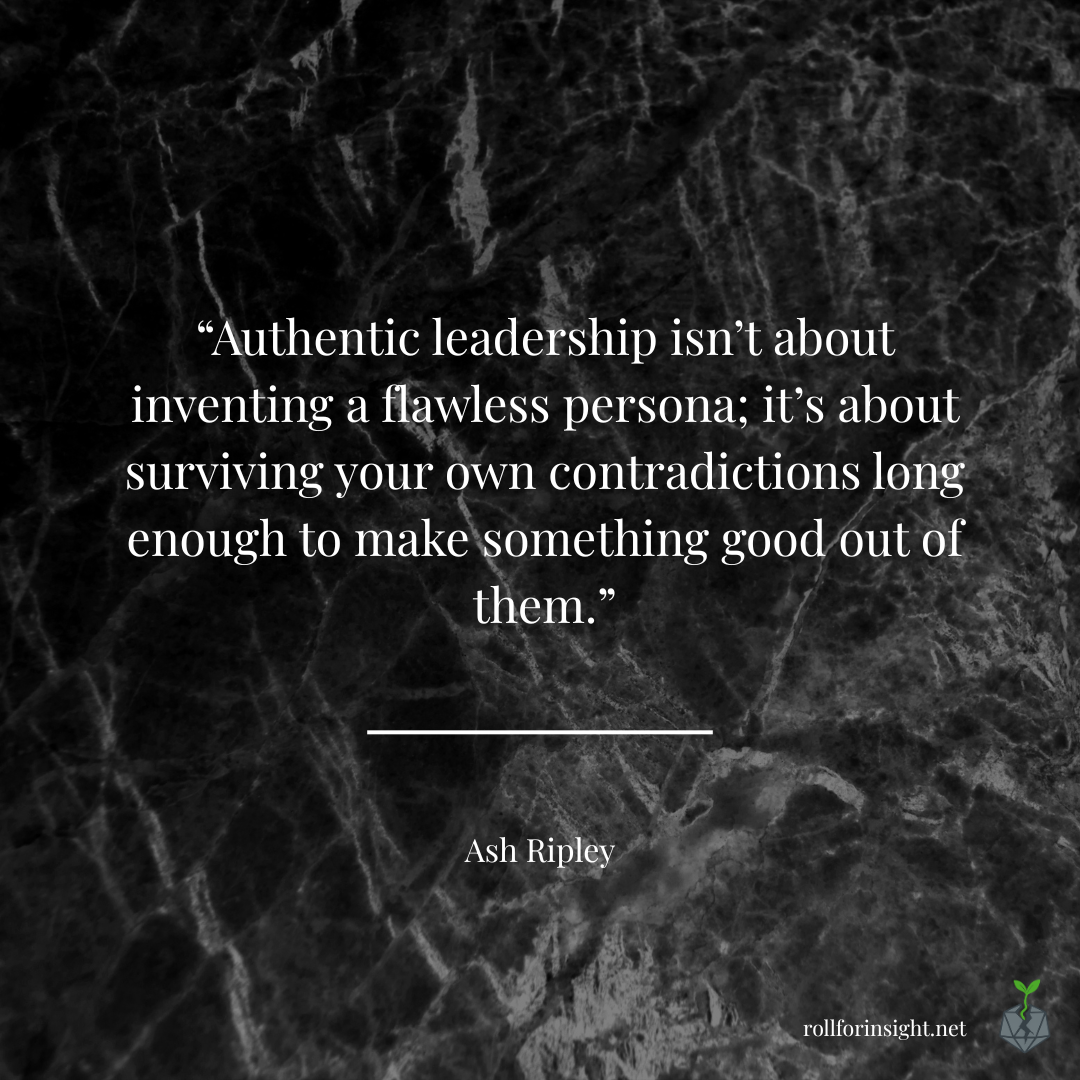
Authentic Leadership, as Illustrated by a Billionaire in a Rubber Suit

The other night, I was reading this dense academic paper about authentic leadership—because that’s pretty much a Tuesday night for me these days—and somewhere around page six I realized I was basically reading the plot of Batman Forever. I don’t mean that in a vague, “the hero’s journey is universal” sort of way. I mean that Karin Klenke’s 2007 paper, Authentic Leadership: A Self, Leader, and Spiritual Identity Perspective, accidentally describes a billionaire in a rubber suit having an existential crisis in a cave.
Klenke says authentic leadership happens when three identities—your self, your leader persona, and your spiritual core—finally stop arguing long enough to form a single coherent being. And I thought, yeah, that sounds right. That’s literally the plot of every Batman movie.
In theory, this is about integration. In practice, it’s about a man who keeps adopting acrobats and dressing like a trauma metaphor. If Klenke were writing for The International Journal of Leadership Studies, Bruce Wayne was conducting field research in emotional damage. Same themes, different font.
Now, before you accuse me of overthinking a movie that features Jim Carrey in a glitter unitard yelling “Joygasm!”, let me assure you: this is the only way to survive the fever dream of Batman Forever with your sanity intact. You have to watch it like a leadership case study written during a psychotic break. Because under all the neon, this movie is basically a presentation about identity management gone feral.
Authentic Leadership, but Make it Weird
Karin Klenke’s model of authentic leadership rests on three overlapping identity systems: the self, the leader, and the spiritual core.1 On paper, that sounds beautifully simple. In practice, it’s like juggling little green squeaky bat bombs while trying to keep your moral compass from spinning.
The self is the version of you that remembers what broke you. It’s every failure and weird formative moment that congealed into your current personality, the way Bruce Wayne’s childhood trauma congealed into…whatever that voice he does is. The self is the personal origin story, complete with flashbacks and questionable coping mechanisms.
The leader is the version of you that smiles like it isn’t still bleeding. It’s the boardroom face, the mission statement in human form, the persona you deploy to convince everyone else that you’ve got a handle on things. This is the part of you that writes reviews while humming “Kiss from a Rose.”
And the spiritual identity—Klenke’s big differentiator—is the one trying to keep both of those versions from texting each other at midnight. It’s the moral and existential glue, the faint sense that maybe you’re supposed to stand for something besides caffeine and panic. When these systems align, you get what Klenke calls authentic leadership. When you don’t, you get Bruce Wayne talking to himself in a cave, dressed in a bat costume, while his butler quietly flips through the Yellow Pages, looking for “grief counseling, but for billionaires.”
She calls it integration; Bruce Wayne calls it compartmentalization with better branding.
Case Study: Bruce Wayne’s Identity Crisis in Dolby Surround Sound
Wayne Manor looks less like a home and more like the crime scene of an identity crisis. You’ve got a portrait of his parents watching over a secret door, a cave of trauma-powered weapons glowing under Victorian furniture, and a butler who pulls double-duty as a crisis manager and grief counselor. It’s not so much a residence as a three-story argument about who Bruce Wayne thinks he is.
From a leadership perspective, Bruce runs two brands with no shared mission statement. The CEO of Wayne Enterprises by day, and the CEO of Punching Crime Through Drywall by Night, neither vision fully trusts the other’s metrics. He’s the kind of manager who’d host a team-building retreat in a cave and then refuse to share the location with the team for “security reasons.” His HR department is just Alfred—holding a tray, wearing a disapproving scowl, and already planning how to clean up whatever moral debris the next night shift produces.
Two-Face and the Riddler operate as his peer reviews. Two-Face represents chaos as clarity—every decision outsourced to a coin toss, the ultimate shortcut for a leader who hates meetings but loves consequences. The Riddler, meanwhile, is pure image-as-identity: a man so desperate for validation that he builds a mind-sucking device to harvest other people’s thoughts and repackage them as proof of his own genius. It’s the ultimate parasitic brand strategy. He doesn’t want to connect with Gotham; he wants to trend there. He’s basically LinkedIn if it achieved sentience, discovered cocaine, and decided murder was a form of networking.
And Gotham itself? The city is what happens when personal branding metastasizes. Every building screams in fluorescent cursive, every statue doubles as a traffic hazard, and the skyline looks like Times Square had a nervous breakdown. It’s the perfect habitat for leaders who confuse visibility with vision.
By the midpoint of Batman Forever, you can practically see the idea forming in Bruce’s head: synergy between personas is suboptimal; recommend deep cave retreat. He’s not just fighting villains—he’s trying to reconcile a boardroom presentation, a childhood wound, and a nocturnal bat fetish into something resembling authenticity. And failing. Spectacularly.
Integration by Explosion
By the end, the whole thing collapses into a neon-lit morality test. The Riddler traps Bruce between two literal representations of his divided life: Chase, the woman who loves Bruce Wayne, and Robin, the partner who believes in Batman. One chain represents connection, the other responsibility. It’s Klenke’s model rendered in glow-stick architecture—self, leader, and spiritual core all dangling over an abyss, screaming for prioritization.
Earlier, when Two-Face had nearly killed Bruce back at Wayne Manor, the Riddler had stopped him with a line that should have been absurd and throwaway—”If you kill him, he won’t learn nothin’.” But standing here in the wreckage, it lands like a prophecy. Because this is the lesson: you can’t destroy the parts of you that make you uncomfortable and expect to grow from the ruins.
This is the moment authentic leadership theorists dream about: forced integration by explosion. All three of Bruce’s identities start demanding hazard pay. He can’t out-fight or out-brand his way through it; he has to pick who he is.
So he does. He stops trying to split himself between the man and the mask, between punishment and purpose. He saves both Chase and Robin—not because he’s Batman, but because, for once, Bruce Wayne shows up, too.
When the smoke clears, Bruce doesn’t rise from the wreckage like a myth; he just walks out, steady and unmasked. The war between his identities isn’t over, but it’s quiet for once. He’s no longer treating Bruce Wayne and Batman like opposing sides of a coin—just different ways of trying to make sense of the same loss. Alfred is there, as always, waiting with that patient look that says he’s seen this before and knows what it costs. And when Bruce tells him he’s both the man and the mask, it finally sounds less like a confession and more like acceptance. The integration Klenke described—the alignment of self, leader, and spiritual core—doesn’t crash down in revelation. It just settles, calm and simple, in the voice of a man who finally knows who he’s been trying to save all along.
The Mask, the Mirror, and the Rest of Us
Most of us wear fewer capes and less rubber armor, but the problem’s the same. The self that cracks jokes at home, the leader who holds it together at work, that part of you is still trying to do something that matters—they all need to be on speaking terms. We can call it balance or work-life integration, but it’s really just trying to get our inner committee to stop interrupting each other. That’s what Klenke was talking about all along: leadership that comes from wholeness, not performance.
Because when those systems fall apart, you don’t get heroes or villains—you just get noise. Every voice in your head competing for airtime, every mask talking over the others until you can’t tell which one is supposed to be in charge. And if you listen close, sometimes the noise even sounds like Seal.
That’s the joke, but it’s also the truth. Authentic leadership isn’t about inventing a flawless persona; it’s about surviving your own contradictions long enough to make something good out of them. Bruce Wayne found his version of that standing in the ruins, finally choosing to be one person instead of two. The rest of us have to find it between commutes, meetings, and whatever passes for a Bat-Signal in our lives.
We don’t get the cave or the costume or the orchestral score, or a skyline that glows like neon guilt. We get the mirror and the question it keeps asking: who’s actually in there with you—and are you ready to let them all be one person?
Endnotes
-
Klenke, K. (2007). Authentic Leadership: A Self, Leader, and Spiritual Identity Perspective. International Journal of Leadership Studies, 3(1), 68–97.
Author’s Note
Yes, I really did read Klenke’s paper for fun. It’s thirty pages long and not one of them features Jim Carrey in a sequin bodysuit, which honestly feels like an oversight.


